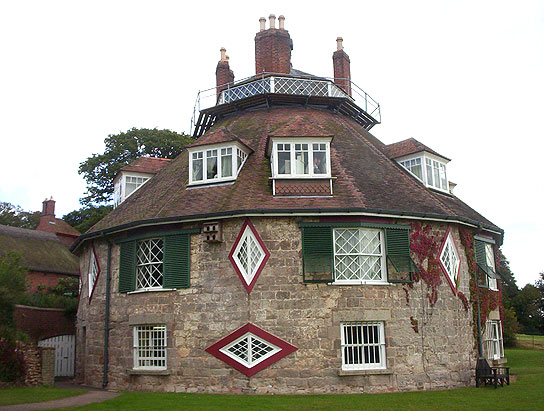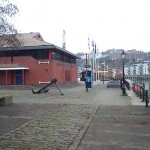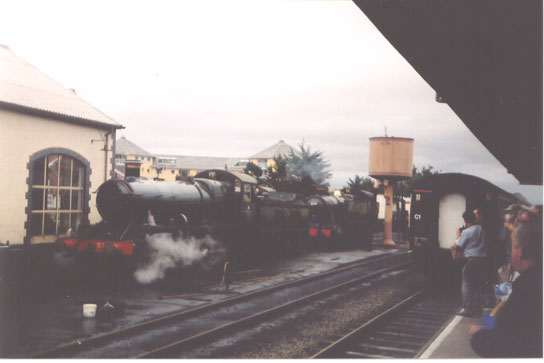English Heritage.
This Iron Age settlement was originally occupied almost 2,000 years ago. The village consisted of stone-walled homesteads known as ‘courtyard houses’, found only on the Land’s End peninsula and the Isles of Scilly. The houses line a ‘village street’, and each had an open central courtyard surrounded by a number of thatched rooms.
There are also the remains of an enigmatic ‘fogou’ underground passage.
The site was presumably in use during the Roman occupation of Britain. Nine homesteads remain, with walls up to about four feet in height. The site is on a hill, with views of the surrounding country. If I remember correctly, access from the car park is by walking a footpath uphill along the side of a field.
Category: South-west
location
Buckfast Abbey, Devon
While the abbey site is ancient, the abbey church is a modern construction, erected by a community of Benedictine monks to the greater glory of God. The monks live at the abbey in a Catholic community.
Visitors are encouraged to visit the church, and also the shop and other visitor facilities.
The church is worth visiting, as it is a reconstruction in Cistercian-Norman style on the original site plan.
Berry Pomeroy Castle, Devon
English Heritage.
The castle dates from the 15th century, and within the outer walls is a great 17th century Tudor mansion, now much ruined. The site is tucked away in a wooded valley, overlooking a steep drop. There is quite a lot to look at in the way of romantically ruined structures, and parts of the castle are quite well preserved. There is an audio tour. It’s worth a visit if you are in South Devon.
Berry Pomeroy Castle is one location where the satnav is less than helpful. If you enter the postcode into Google Maps, satellite view, you can see just why I found myself on the wrong road, going in the wrong direction, and a mile from the castle. I had to ask a local for directions. The roads in the vicinity are single track, with no visibility.
A La Ronde, Devon

National Trust.
A unique sixteen-sided house, built for two spinster cousins after their return from a grand tour in the 18th century. It looks like something from a child’s imagination, and its cramped rooms contain large collections of curious objects. There is a feather frieze composed of feathers of many species of birds, and on the top floor is a shell-encrusted gallery, said to be composed of about 25,000 shells, which because of its fragility and problems of access has to be viewed by closed circuit television. Outside is a small garden, and there are great views of the Exe estuary.
SS Great Britain, Bristol

In 1970 the rusted hulk was recovered and towed back to Bristol for restoration and display. Restoration has continued from the 1970s to the present day.
I’ve visited the ship two or three times, and seen changes each time. Today’s visitor will see the innovative “waterline” glass roof which looks like water from above, but below provides a low-humidity space to conserve the hull and allow the underwater shape and propeller etc to be seen. The hull has been conserved and holes patched with fibreglass, decks have been repaired and renewed, a 1845 replica steam engine has been fitted, and replicas of various cabins and the passenger saloon have been fitted.
In addition to the ship itself, there is a museum of artefacts from the ship’s history, and a dock where other vessels are moored.
Sept 2014: No huge changes since my last visit, but there are now lifelike mannequins posed in various cabins. There is a realistic recreation of the stokehold forward of the lower engine room. The galley is fully fitted out (it even has a rat and dirty dishes), as are the steerage sleeping areas and the first-class promenade deck and dining room. In fact most of the ship is now fully fitted out to replicate its early layout and usage, with the exception of the forecastle (closed) and the forward hold (a stripped-out hole) and boiler room (a modern function space).
It looks that the ship’s boats will be added next, as replicas are on the quay-side.
Well worth a visit if you are at all interested in history, or Britain’s maritime heritage.
Finding the ship may be easier with satnav, but it is possible to find it by following the brown anchor signs. There is a pay car park – the parking meter makes one pass an IQ test on parking one’s car, entering the numeric half of the car registration. However long you park, you only have to pay £2, as you can claim the rest back when buying your Great Britain ticket.
It is possible to see the ship in about one and a half hours, but there is a historic dockside nearby that is worth a stroll.

Fleet Air Arm Museum, Somerset
The Fleet Air Arm is the flying section of the Royal Navy, and the collection concentrates on naval aircraft. Continue reading “Fleet Air Arm Museum, Somerset”
Barrington Court, Somerset
National Trust
This mid-sixteenth century house has a spiky outline of gables and chimneys and is built to a characteristic Elizabethan E-plan. Barrington was the first country house to be acquired by the National Trust, and it could be said that the NT has learnt by its mistakes. Ever since, the NT has been wary of accepting a house without a substantial endowment to provide for its upkeep. Barrington came to the NT as a derelict gutted shell with few original internal features remaining. Its present authentic-looking internal appearance is due to the sympathetic attention of an early tenant, Colonel A Lyle (of sugar fame) who lined it with his collection of interior fittings salvaged from contemporary derelict buildings. Every house seller knows that a house looks better with the rooms kitted out with furniture and fittings, and today Barrington is leased to Stuart Interiors for the display of period and reproduction fine furniture.
Today, the rooms, including the gallery on the top floor, make an interesting visit. The house exterior is attractive, and surrounded by lawns, a partial moat and gardens.
Lynton and Barnstaple Railway
This is a narrow-gauge railway, re-created over part of an old route near Exmoor. The route is quite short, and once you’ve ridden the train and had tea there probably isn’t a lot else to do. The rolling stock includes two small steam locos and one diesel. Worth a visit when combined with other attractions in the same area.
Severn Valley Railway
This preserved steam railway runs from Bridgnorth to Kidderminster. There are 6 stations and about 16 miles of track. It recreates the feel of railway travel of a past era quite well. The line has been prone to landslips, and if I remember correctly, there were places where the train trundled slowly past the greenery and one could see trackside fittings that had obviouly moved several feet laterally. Near the tracks there are various things to look at, including The Engine House, a new museum and visitor centre, and touristy stuff in the towns along the line. The line now carries around 250,000 passengers annually. At one time there was an annual folk festival at Bridnorth, and they had a Folk Train excursion to pubs with folk music sessions in a couple of picturesque towns down the line. We got to play music on the train too. You could have a similar inebriated outing – just leave out the folk music.
West Somerset Railway

There is a car park adjacent to Minehead station. On the one occasion I travelled on the railway, I allowed two hours to travel from another part of Devon, and ended up driving at rally speeds for the last hour to catch my train, and caught it with 3 mins to spare. Devon roads are slow. You have been warned.
Minehead is a tourist resort, and there are a few other items of interest near the railway, e.g. Dunster Castle.
